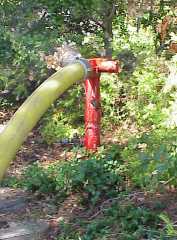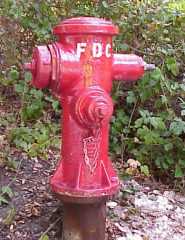- All discharge hydrants shall be "pumper" style, Model 64 or equal.
- All piping shall be rated at for a working pressure equal to
the pressure required to sustain 1000 GPM from the engine pumping at the scene,
but not less than 150 p.s.i., and be capable of withstanding static tests of
two times the working pressure.
|
- Older intakes are conventional FDC design with dual 2½" female
swivels.
Standard FDC

|
- Since the district adopted the LDH standard, newer intakes are pumper hydrants
clearly marked as FDCs. Typically we use older hydrants which were taken out of
service but which are still functional.
Hydrant used as FDC

|
|
(Designing the system to work with LDH versus multiple 2½" lines provides several
advantages such as eliminating most friction loss from the layout, reducing necessary
relay operating pressures and eliminating large pressure swings between
static and full flow operations.)
|